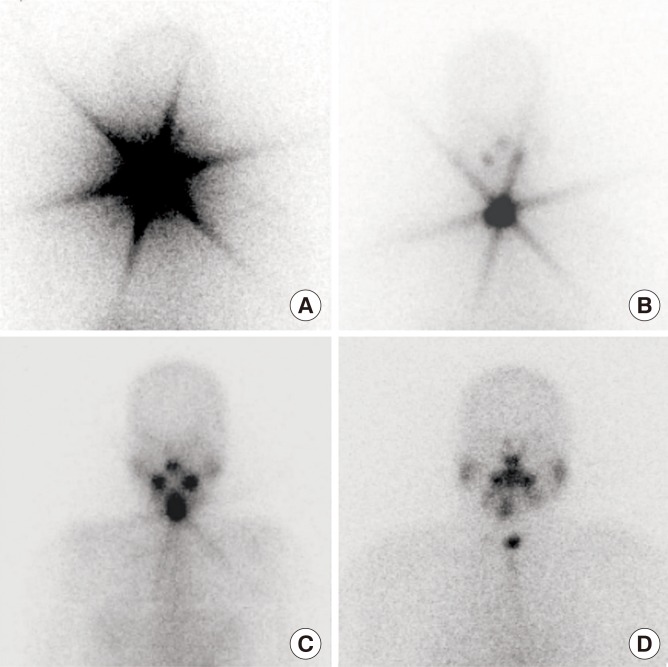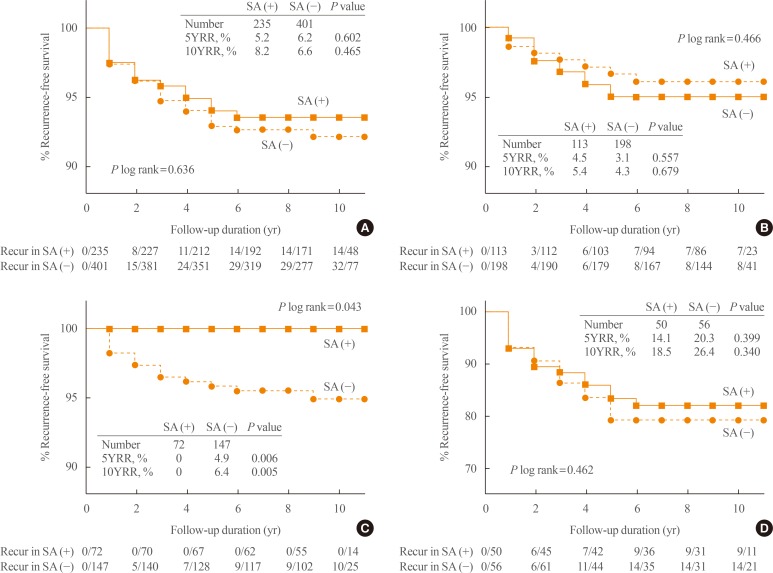Endocrinol Metab.
2018 Jun;33(2):228-235. 10.3803/EnM.2018.33.2.228.
Star-Shaped Intense Uptake of ¹³¹I on Whole Body Scans Can Reflect Good Therapeutic Effects of Low-Dose Radioactive Iodine Treatment of 1.1 GBq
- Affiliations
-
- 1Department of Internal Medicine, Seoul National University College of Medicine, Seoul, Korea. yjparkmd@snu.ac.kr
- 2Department of Internal Medicine, National Medical Center, Seoul, Korea.
- 3Department of Internal Medicine, Seoul National University Hospital, Seoul National University College of Medicine, Seoul, Korea.
- 4Department of Internal Medicine, Seoul National University Bundang Hospital, Seoul National University College of Medicine, Seongnam, Korea.
- 5Department of Internal Medicine, Seoul Metropolitan Government Seoul National University Boramae Medical Center, Seoul National University College of Medicine, Seoul, Korea.
- 6Department of Internal Medicine, Chung-Ang University Hospital, Chung-Ang University College of Medicine, Seoul, Korea.
- KMID: 2420491
- DOI: http://doi.org/10.3803/EnM.2018.33.2.228
Abstract
- BACKGROUND
After initial radioactive iodine (RAI) treatment in differentiated thyroid cancer patients, we sometimes observe a star-shaped region of intense uptake of 131I on whole body scans (WBSs), called a "˜star artifact.' We evaluated the clinical implications of star artifacts on the success rate of remnant ablation and long-term prognosis.
METHODS
Total 636 patients who received 131I dose of 1.1 GBq for the initial RAI therapy and who did not show distant metastasis at the time of diagnosis were retrospectively evaluated. A negative second WBS was used for evaluating the ablation efficacy of the RAI therapy. Among them, 235 patients (36.9%) showed a star artifact on their first WBS.
RESULTS
In patients with first stimulated thyroglobulin (sTg) levels ≤2 ng/mL, patients with star artifacts had a higher rate of negative second WBS compared with those without star artifacts (77.8% vs. 63.9%, P=0.044), and showed significantly higher recurrence-free survival (P=0.043) during the median 8.0 years (range, 1.0 to 10.0) of follow-up. The 5- and 10-year recurrence rates (5YRR, 10YRR) were also significantly lower in patients with star artifacts compared with those without (0% vs. 4.9%, respectively, P=0.006 for 5YRR; 0% vs. 6.4%, respectively, P=0.005 for 10YRR). However, ablation success rate or recurrence-free survival was not different among patients whose first sTg levels >2 ng/mL regardless of star artifacts.
CONCLUSION
Therefore, star artifacts at initial RAI therapy imply a good ablation efficacy or a favorable long-term prognosis in patients with sTg levels ≤2 ng/mL.
MeSH Terms
Figure
Reference
-
1. Haugen BR, Alexander EK, Bible KC, Doherty GM, Mandel SJ, Nikiforov YE, et al. 2015 American Thyroid Association management guidelines for adult patients with thyroid nodules and differentiated thyroid cancer: the American Thyroid Association guidelines task force on thyroid nodules and differentiated thyroid cancer. Thyroid. 2016; 26:1–133. PMID: 26462967.
Article2. Chung JK, Cheon GJ. Radioiodine therapy in differentiated thyroid cancer: the first targeted therapy in oncology. Endocrinol Metab (Seoul). 2014; 29:233–239. PMID: 25309780.
Article3. Wartofsky L, Van Nostrand D. Chapter 36 part A, Stunning: untoward effect of 131I thyroid imaging prior to radioablation therapy. Thyroid cancer. Totowa: Humana Press Inc.;2006. p. 337–345.4. Anastasios G, Foteini C, Dimitrios T, Philippos K. Functioning metastasis of papillary thyroid carcinoma originating as a double star effect on the post-therapeutic radioiodine whole body scan. Intern Med. 2008; 47:1155–1156. PMID: 18552478.
Article5. Schneider DF, Ojomo KA, Chen H, Sippel RS. Remnant uptake as a postoperative oncologic quality indicator. Thyroid. 2013; 23:1269–1276. PMID: 23373869.
Article6. Filetti S, Bidart JM, Arturi F, Caillou B, Russo D, Schlumberger M. Sodium/iodide symporter: a key transport system in thyroid cancer cell metabolism. Eur J Endocrinol. 1999; 141:443–457. PMID: 10576759.
Article7. Mazzaferri EL, Kloos RT. Using recombinant human TSH in the management of well-differentiated thyroid cancer: current strategies and future directions. Thyroid. 2000; 10:767–778. PMID: 11041454.
Article8. Choi H, Lim JA, Ahn HY, Cho SW, Lee KE, Kim KW, et al. Secular trends in the prognostic factors for papillary thyroid cancer. Eur J Endocrinol. 2014; 171:667–675. PMID: 25163726.
Article9. Gibelli B, Tredici P, De Cicco C, Bodei L, Sandri MT, Renne G, et al. Preoperative determination of serum thyroglobulin to identify patients with differentiated thyroid cancer who may present recurrence without increased thyroglobulin. Acta Otorhinolaryngol Ital. 2005; 25:94–99. PMID: 16116831.10. Kim TY, Kim WB, Kim ES, Ryu JS, Yeo JS, Kim SC, et al. Serum thyroglobulin levels at the time of 131I remnant ablation just after thyroidectomy are useful for early prediction of clinical recurrence in low-risk patients with differentiated thyroid carcinoma. J Clin Endocrinol Metab. 2005; 90:1440–1445. PMID: 15613412.11. Min JJ, Chung JK, Lee YJ, Jeong JM, Lee DS, Jang JJ, et al. Relationship between expression of the sodium/iodide symporter and 131I uptake in recurrent lesions of differentiated thyroid carcinoma. Eur J Nucl Med. 2001; 28:639–645.
Article
- Full Text Links
- Actions
-
Cited
- CITED
-
- Close
- Share
- Similar articles
-
- Comparosin of Pretreatment and Postreatment Whole Body Iodine-131 Scans in Patients with Differentiated Thyroid Carcinoma
- Camprison of Diagnostic and Therapeutic scans in Patients with Differentiated Thyroid Cancer
- Assessment of Absorbed Dose of by Organ according to Thyroidal Uptake of Radioactive Iodine for Adult Korean Males
- Physiological Uptake of Radioactive Iodine Around an ArtificialEyeball Observed with Single-Photon Emission ComputedTomography/Computed Tomography After RadioactiveIodine Treatment
- The size and radioactive iodine 131-I uptake rate of thyroid glands of Korean woman



